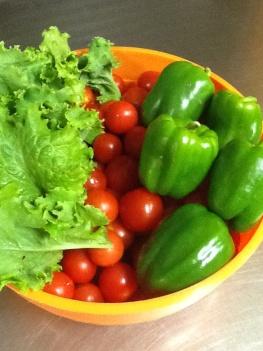Kids Garden at Larson Elementary, Harrison, Michigan

A presentation at the April 2013 Together We Can summit created the spark for a garden at Larson Elementary School in Harrison, Michigan. The principal, Julie Rosencrantz, knew that many kids in the school didn’t have access to the fresh fruits and vegetables they need to be healthy and saw a garden as an opportunity to change that. By June, kids were eating the fruits and vegetables they had grown, in the garden and on the school’s salad bar.
Sarah Kile, a Health Educator at the Central Michigan District Health Department, credits the entire Harrison community for this accomplishment: “We have the greatest people on the planet,” she said.
A small group led by Rosencrantz, Kile, and staff from the school’s after-care program started the process by making lists of tasks and seeking partners to get the jobs done. A Community Transformation Grant-Small Communities provided funding for supplies such as lumber, soil, fertilizer and seeds, but the group still needed labor to dig holes, build raised beds, and plant trees. Sharing a message of healthy communities and better nutrition the team leveraged networks to enlist people who really wanted to see a garden become a reality. They spread the word through personal conversations, various community meetings, and even an article in the local paper. Parents donated time and machinery to start the garden, and the kids kept it running, with a little help—Rosencrantz watered on weekends, and residents at a nearby assisted living facility helped to water and weed.
Throughout this journey, the team never lost sight of its broader goal: improving the health of the community over the long-term. Going forward, more than 20 fruit trees will provide apples, cherries, and pears for years to come; students are planning to grow and sell popcorn to buy seeds for next year’s planting; and there are plans to bring gardens to students’ homes with "how to" booklets and seed packets.
This effort cost approximately $6,500 to launch, but Kile believes Harrison’s experience suggests a garden could be started for less, with even more support from local businesses and community members. “Find your champions,” she said, “but don’t stop there, keep an eye on your long-term goals.”
To learn more, contact: [email protected].
Communities in Action provide examples of strategies or tools in action. Their purpose is to connect like-minded communities in their implementation efforts, giving insight into how others are tackling key challenges and what they've accomplished. To learn more about the evidence supporting this strategy's effectiveness or resources to help move towards implementation, see the What Works for Health summary of School fruit & vegetable gardens.
Date added: March 26, 2014
